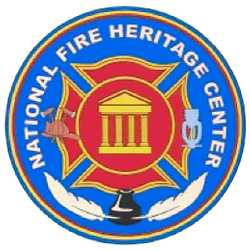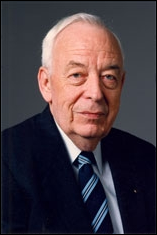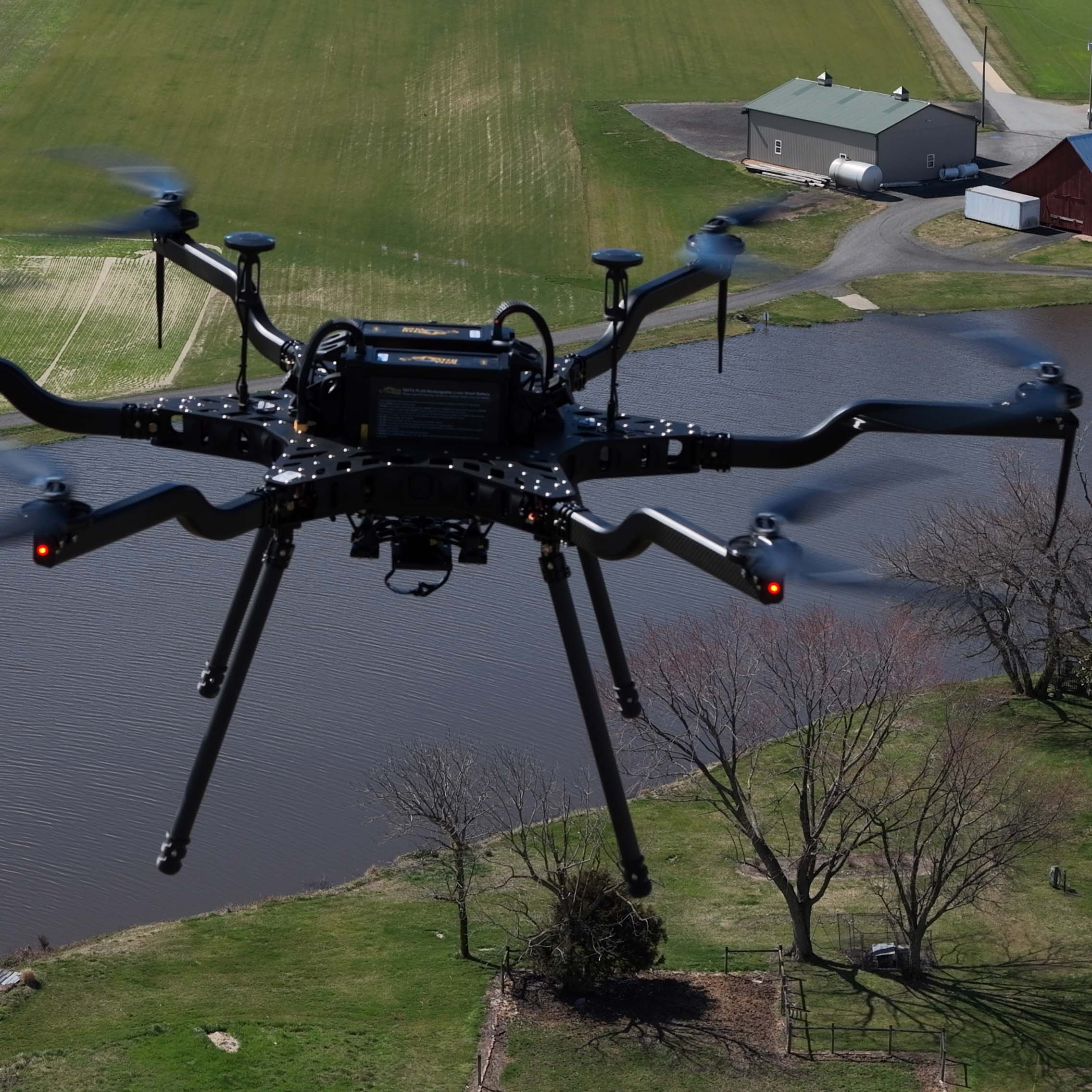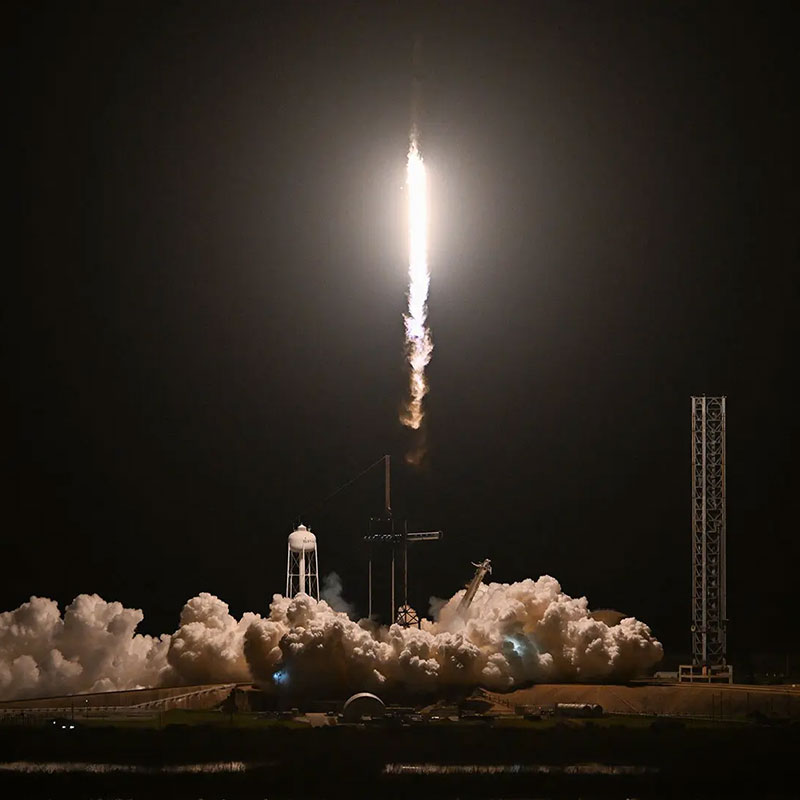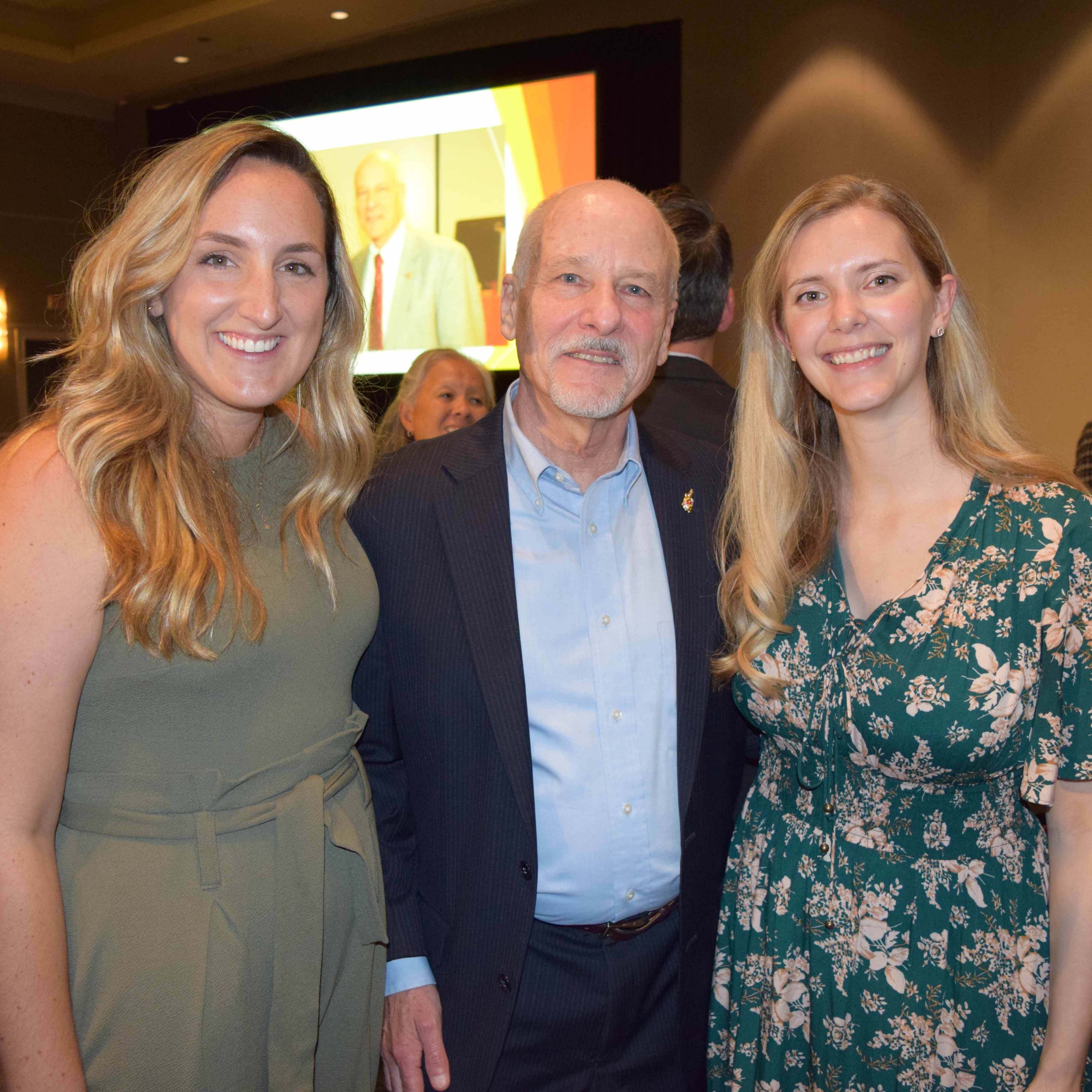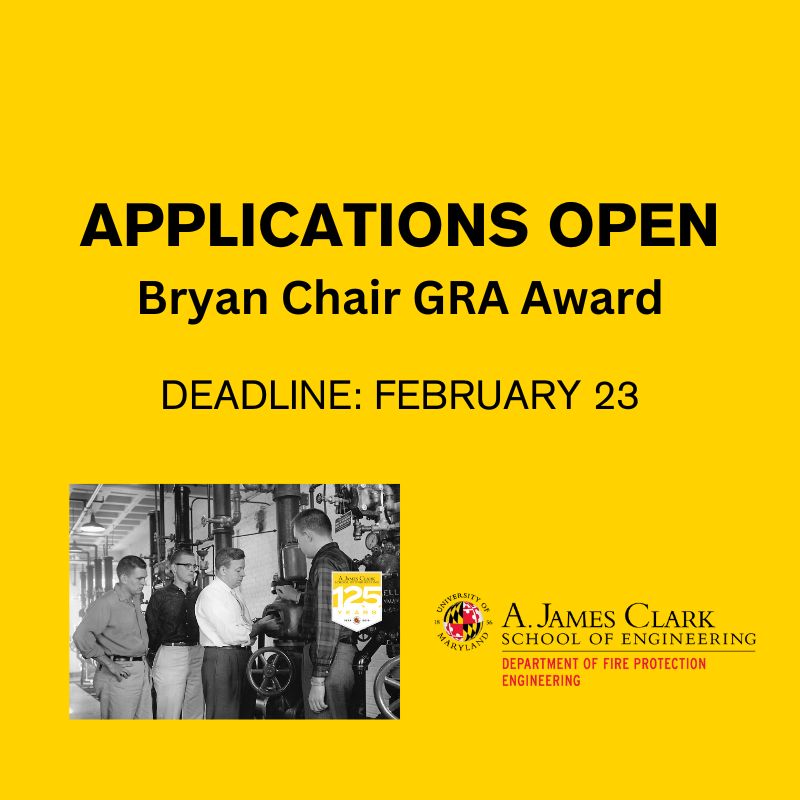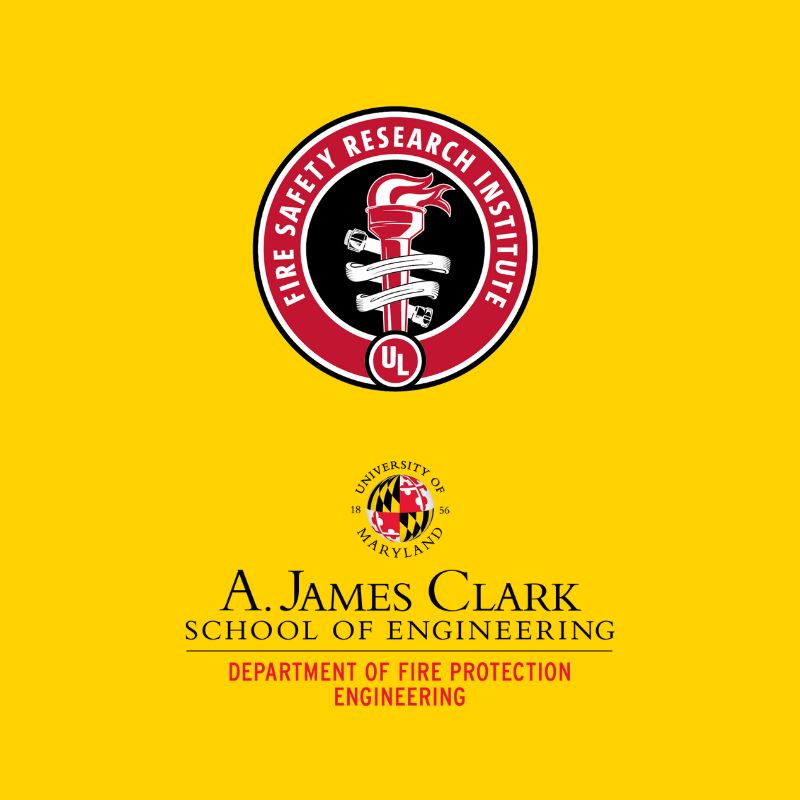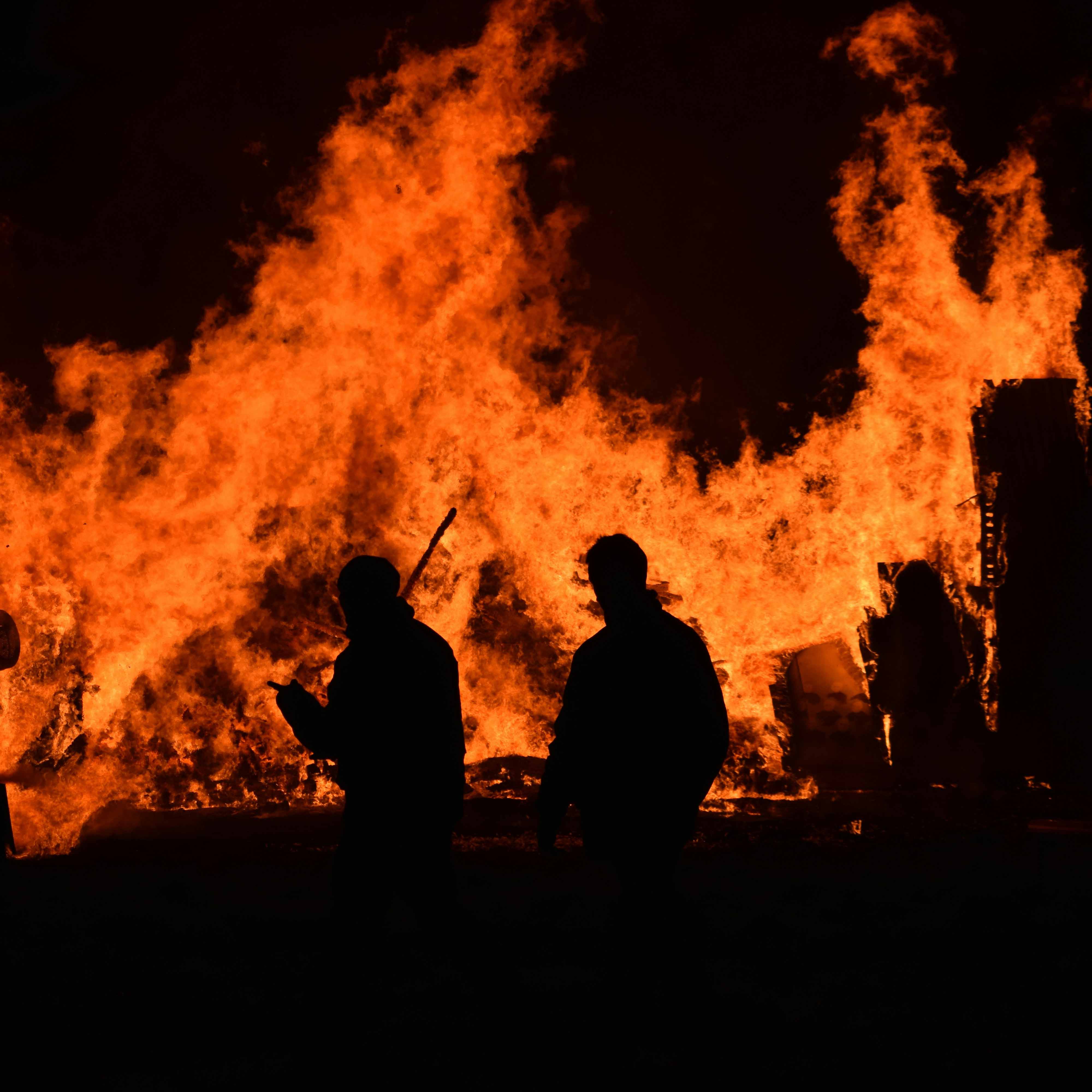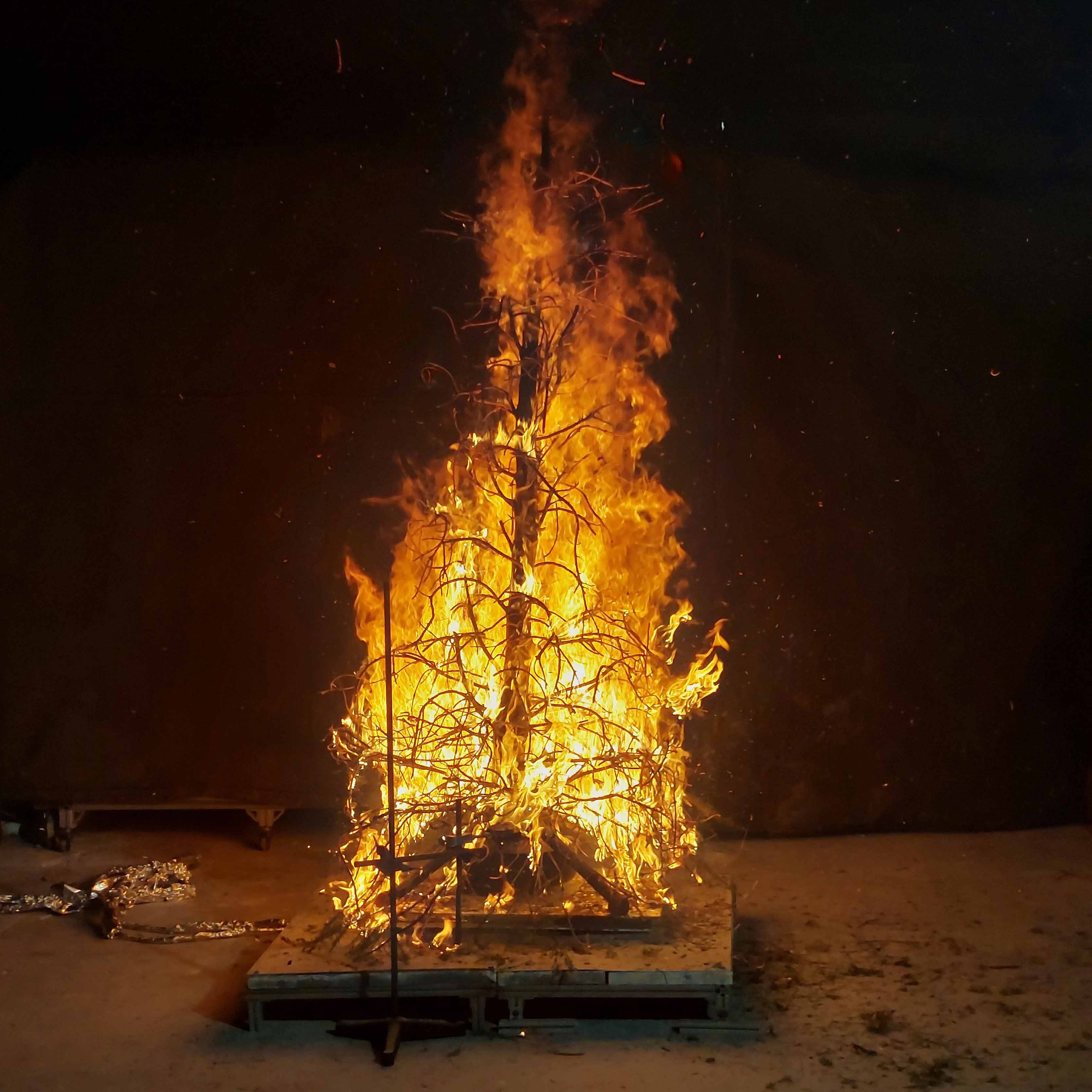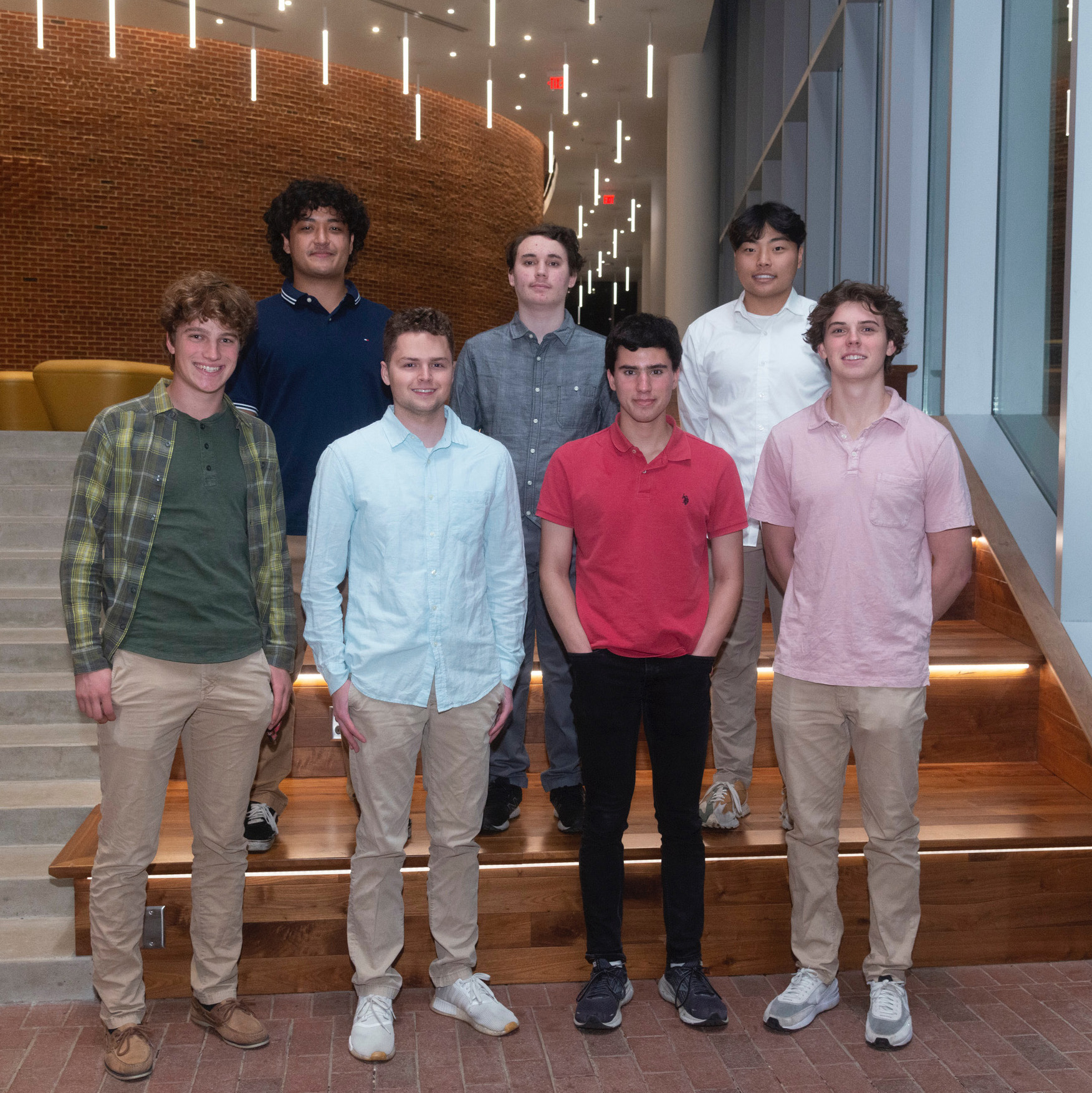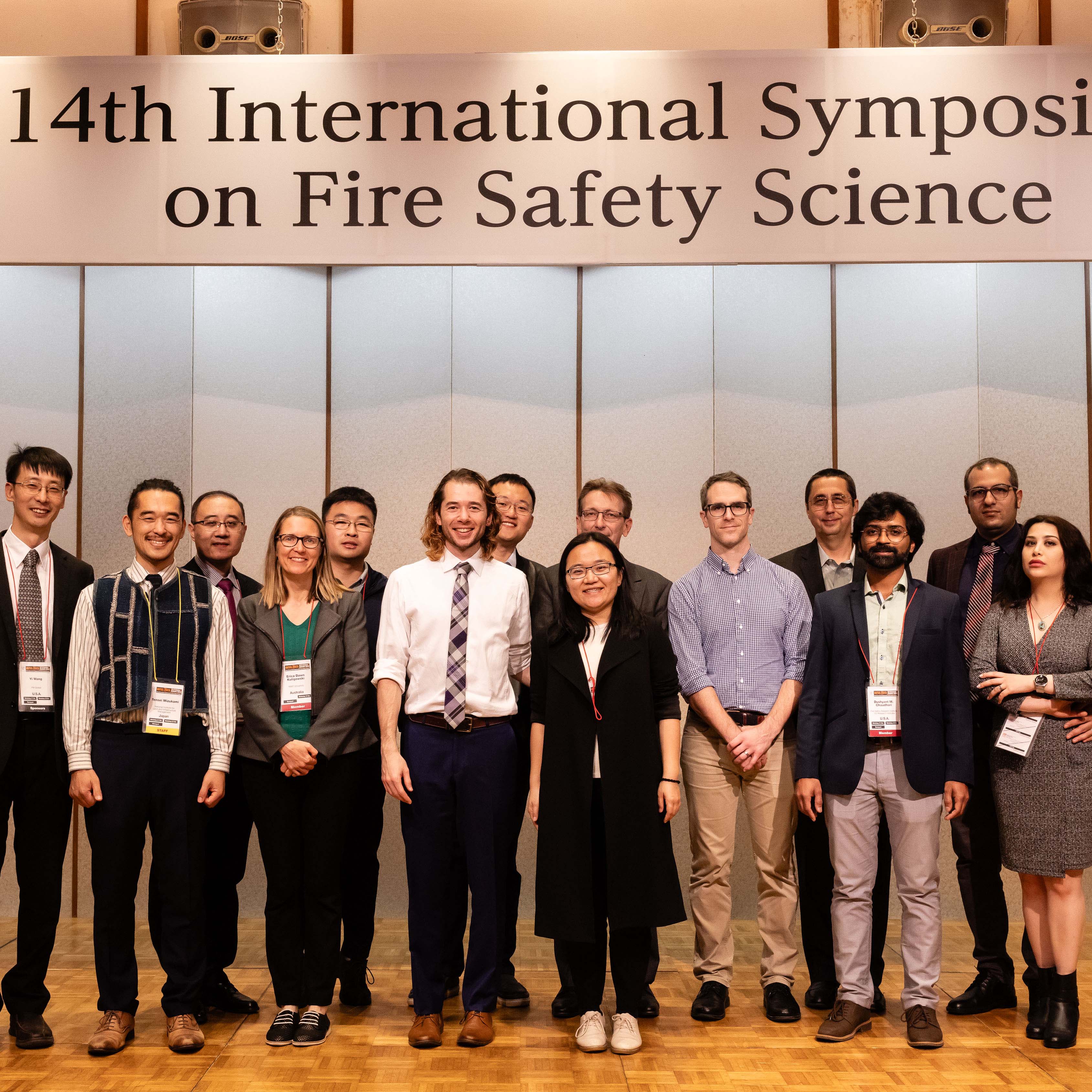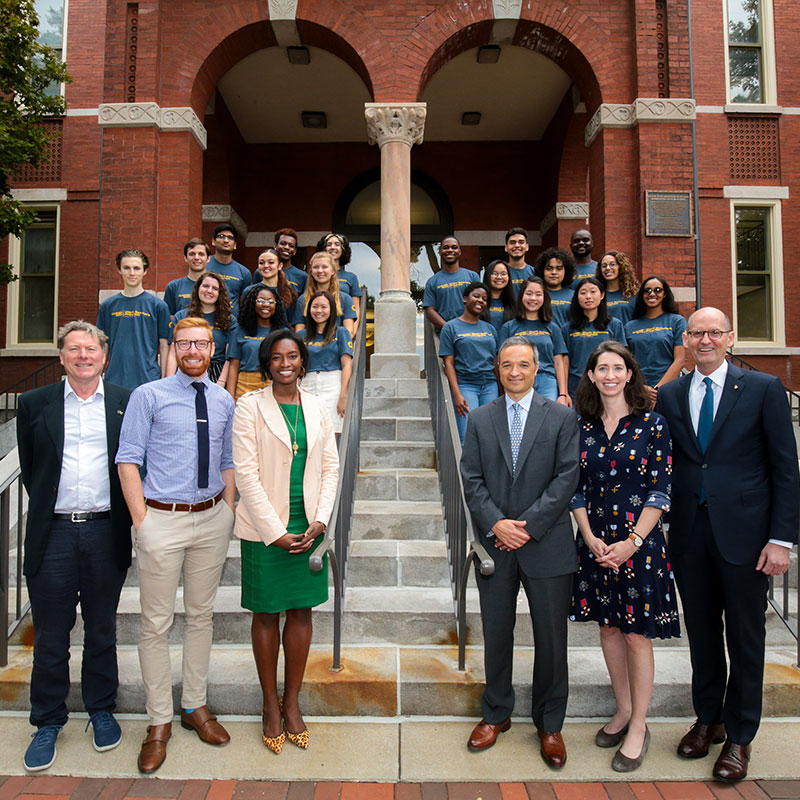News Story
Three Tributes to John L. Bryan
Family, friends and colleagues from around the country gathered in Frederick, Md. November 17 to remember “Prof,” the Department of Fire Protection Engineering’s founding Chair, Professor John L. Bryan (1926–2014). Dr. Bryan’s family has asked FPE to share the following three tributes from the memorial service, given by current FPE Professor and Chair Jim Milke (B.S. ’76), Mark Henry Salley (B.S. ’87 and M.S. ’00) and Deidre Willard (B.S. ’88).
Jump to:
“Tribute to Dr. John L. Bryan”
FPE Professor and Chair Jim Milke, Ph.D., P.E., B.S. '76
I’m Jim Milke, Professor and current Chair of the Department of Fire Protection Engineering at the University of Maryland. On behalf of the faculty and staff, it’s my honor to present a tribute for Dr. John Leland Bryan, founder of the Department and Chair for its first 37 years. This department has awarded degrees to more than 1,500 individuals since its inception in 1956. I was one of those 1,500 and was among the fortunate to have had an opportunity to be one of the faculty members in the department that he created.
As a historical sketch, in 1950, the Maryland volunteer fire service initiated discussions of the need for a fire protection engineering curriculum at the University of Maryland. In 1954, John Bryan was recruited to return to his home state by the Fire Service Extension at the University of Maryland to develop a program in fire protection engineering. So, from 1954 to 1956 he was tasked with developing the proposal for the program, having to persuade key people along the way, all before he had reached his 30th birthday!
On Jan. 30, 1956, he met with Governor Tawes to talk about funding for the department. This meeting reportedly included helpings of Calvert whiskey (not his favorite drink). The meeting occurred on a Sunday and was the day after the Arundel Park fire where 11 people died and hundreds were injured in Brooklyn, Maryland. Prior to the fire, there was already strong momentum for the fire protection engineering program. With the public outrage about the fire, the timing was perfect for proposing a fire protection engineering program. So, John Bryan was the right person with the right vision at the right time and the right place.
While the state provided financial support for the program, everyone at the university did not embrace this new department, so in the initial years John Bryan, “Prof,” had to ward off frequent attacks on the department and the resources provided to it. Nonetheless, he was able to grow the department and in 1960 Harry Hickey became the second faculty member (yes Prof was the lone faculty member for the first 4 years!) and then added Dick Custer, a third faculty member in 1967, which was the number of full time faculty in the department until 1990.
In the mid-1970’s, Prof obtained a funded research grant to study human behavior in fire, an area of study for which he became well-known. He had a group of undergrads work for him on this Project People grant and I was one of them. This grant was his second study about human behavior; his first one analyzed the human behavior in the Arundel Park Fire.
The mid-70’s was a time when Prof was successful in having the program receive its 1st ABET accreditation and the Department was starting to grow its research activities. The Department was maturing and taking on the shape of other engineering departments at Maryland, an essential trait for longevity.
With the department’s growing research activity, Craig Beyler, Phil DiNenno and I were the initial set of graduates working on research projects. Phil worked with Prof on a 2nd Phase of Project People. I initially worked with Jack Watts, though once that project ended, I transitioned to the Project People study after Phil left. To this day, I am honored to be a co-author of the final reports on the Project People II study with Prof and Phil.
Jack Watts was the fourth full-time faculty member in the Department. When Jack Watts announced his departure from the University, Prof offered me Jack’s position starting in the fall of 1981. This offer was made without a formal search, without me having to go through a formal interview and without me having a Ph.D. This is all contrary to University policies, yet somehow, Prof was able to work through the red tape to offer me that position. So, I became the fifth full-time faculty member hired in the Department, and Fred Mowrer and Jim Quintiere followed. Jim Quintiere assisted in developing the proposal for a graduate program in the field. Steve Spivak and Vince Brannigan joined when their department was disbanded, which Prof saw as an opportunity to add 2 more faculty lines in the Department, raising the total to 6 by the time of his retirement.
I believe I’m incredibly fortunate to have had the opportunity to work with Prof at the University from 1977 until his retirement in 1993, learning from him while he was instructing or by simply observing him as a role model. For any of us who joined the department as junior faculty, he was our professional mentor. For me in particular, because my father passed away a little more than 2 years after I joined the faculty, Prof became a father figure for me and was my beacon for professional development for all the years of my career. But, he did that for all new faculty, because it was the right thing to do. He was a natural mentor – caring for the development of others so that they could excel. That’s the definition of a leader. SFPE recognized that trait in him when instituting the John L. Bryan Mentor Award in 2007. Even after his retirement, I’d relate accomplishments to Prof via phone calls and whenever I’d see him. In fact, something happened just last week and I thought, “I need to call Prof and tell him."
As if being on the faculty with him wasn’t amazing enough, in 1988 he invited me to work with him on a short course for the Fire Marshals Association of North America. Several of you also had the fortune to teach seminars and short courses with him. We taught our first short course in 1989, and subsequently taught this week-long course a few times a year around the U.S. and Canada for about 15 years (including 2 trips to Hawaii). During these weeks, I had the fortune to be in airports, planes, rental cars and eat breakfast, lunch and dinner with him for a week at a time. During our time together on the road, we’d talk about a variety of things, from fire protection issues to Maryland basketball. During these trips, I learned that it was important to recover after a long day of teaching by having a Beefeaters martini on the rocks with a twist – for medicinal purposes, as he’d say.
As a result of the day-to-day interactions and weekly trips, we got to talk about many personal things. Now, Prof was a very private individual, and he didn’t speak about personal things very often. The principal exceptions were when he’d tell me about someone in his family having a serious illness, such as when he called me at home one day to tell me the devastating news about Sarah’s diagnosis of terminal cancer.
He devoted his life to the creation and livelihood of a Department of Fire Protection Engineering. But he also devoted his life to the important people around him. For sure, these included his wife and children, but his ‘family’ also included the group of students, graduates, and all the people who had the chance to work with him. Finally, his many accomplishments were never about him. Routinely, when addressing any accolades of the many awards he received, he’d deflect the recognition to acknowledge the many people he worked with. While team members can contribute to a successful operation, a strong leader is essential. John Bryan was a strong leader with a vision. He created the Department of Fire Protection Engineering at the University of Maryland. But in addition to creating this administrative unit at a major university, he infused the sense of caring into the group of people who entered through the doors of that department. That’s his legacy.
“A Tribute to Dr. John L. Bryan”
Deidre Willard, B.S. ’87
Thank you, Jim. Like you, I am honored to be here today paying tribute to a man that I respected, loved and who affected my life in a very profound way. It is obvious from the many conversations I’ve had with other alumni and by reading the on-line tributes, that all of us here today will truly miss Prof and are all better people for knowing him.
I first met Prof in the spring of 1986. It was at the suggestion of a sorority sister, Karen Kretschmann, who was studying Fire Protection Engineering and would soon graduate from the program. At the time, I was in the middle of my second semester of aerospace engineering and in my junior year of college. I was very unhappy in aerospace but loved engineering. Karen introduced me to Prof, and it was a life changer. After I met with Prof, I knew the fire protection engineering department was where I needed to be, and the path I would take. Prof made me feel welcome within 15 minutes where I never felt welcome in aerospace after almost two semesters. I had been looking for a home and found it with fire protection. I wanted to be part of a profession that affected the greater good and could possibly make a difference in many people’s lives. It was the one conversation, one decision, that changed my life forever and took me down a path I would not have taken otherwise.
Like me, I know there are many others here today that had similar experiences whether it was declaring “undecided” for a major, or finding you really hadn’t found the right engineering discipline for yourself. You just needed to meet Prof to help you make that decision. Like Steve West. Steve is a 1979 grad of the program and was undecided in his major until he met Prof. He took the ENES 101 class and heard Prof speak about the program and signed up that same day to pursue FPE. John Denhardt, a 1986 grad, has his own story, similar to Steve’s but with a slight twist. John also took ENES 101 but had a meeting just with Dr. Bryan. After that meeting he was considering fire protection but had not made a decision yet. Then about a week after the meeting, John was walking down the hall and saw Prof. Prof noticed him and said “John.” He replied “Yes, sir.” Prof said, “I just want you to know that if you have any questions or if there is anything I can do to help you, to please let me know.” John was so surprised that he had remembered his name and knew then that he needed to be a fire protection engineer.
And then there’s Mike Thompson, who is a 1977 grad of the program, where Prof “cut through the red tape” that Jim mentioned. Mike wanted to be a fireman. His parents did not support that idea. So, he applied to multiple colleges and universities. His dad worked in the same building as NFPA, and he met Tony O’Neill, John O’Neill’s brother (another grad of the program) while commuting to work, who told him he thought his son should pursue fire protection engineering at the U of M. So, Mike and his Dad took a trip down to MD and Mike was sold. Prof told him to get his application in, and he’d see him in August. Mike did just that and also sent letters to the other schools letting them know he wouldn’t be coming there. Then he received a letter from U of M indicating he had not been accepted. He immediately called Dr. Bryan who told him not to worry about it and to come on down to Maryland in August. About two weeks prior to the start date, Mike called Dr. Bryan again. He said don’t worry, ignore the letter, and come to school on August 15th. Mike eventually received an orientation packet and the rest is history.
Prof was always supportive. I remember when I chose to do a project on human behavior. I got blank stares and silence when I mentioned it to my other classmates. This happened to be my first semester in fire protection and little did I know that that was Prof’s focus and had spent many years studying it. After I found out, I went to Prof to ask for his help. And in his typical style, he supported me in so many ways with sharing his knowledge directly, identifying references for me to review and answering any questions I had along the way. He challenged you, made you do better than you would have done otherwise and truly cared. He might give you a snowman every now and then, letting you know he knew you were trying to “snow” him, but he always wanted everyone to do their best and be successful. I think that’s one reason why he took such care in knowing everyone’s name, their spouse’s name, and often times their children’s names, as well as where you worked. I don’t know one other person that can do that. But Prof did. And I believe that that was his small way of demonstrating how proud he was of each of us and that it mattered to him what we did with what we learned.
As many of you probably remember, he had a very close relationship and loving partnership with his wife Sarah. They met and got married in 1950 shortly after Sarah graduated with a degree in journalism. Sarah helped support him while he finished his bachelor’s degree, master’s degree and ultimately his Ph.D. They truly were a match made in heaven with her by his side till her passing in 1996. Prof and Sarah supported diversity in engineering, and Sarah was a strong supporter of women in the field. As a result, he established the scholarship in her name to help women pursue a degree in fire protection. That scholarship continues today and helps multiple women every year with monetary support. There are other scholarships available, too. Without Prof recommending us or encouraging us to apply for them, I don’t know if many of us would have completed the program at MD without it. In my case, the money was gone since I was originally on the 4 year plan, not anticipating I’d change my major in my junior year. Prof found out about my challenge and at his suggestion, I applied for the Frank J. Fee, Jr. Award. I received the award my last semester that covered my full tuition. Again, another example of Prof Bryan at work.
Dr. Bryan and Sarah retired to Frederick before her passing. As a result of their location and also attending the same church we do, this church, we got to see Prof almost every Sunday. Our children, Jack and Paige, got to know Prof over the years and enjoyed sitting next to him during the service and inviting him to have donuts with them during coffee hour. We were able to have dinners with him at his home, at ours, and during various occasions at Dutch’s Daughter. I got to know his daughter, Joan, and meet her husband and Prof’s grandchildren. I feel blessed to have gotten to know Prof and part of his family in such a personal way.
I believe part of God’s most important commandment from Mark, Chapter 12, exemplifies who Prof was: “You will love your neighbor as yourself.” Prof truly cared about everyone he knew and loved us all.
I’d like to close with descriptive words that I’ve heard shared by Jim this morning, by others and that come to mind when I think of him.
Entrepreneur
Scholar
Leader
Teacher
Coach
Mentor
Intellectual
Role Model
Father Figure
Grandfather Figure
Visionary
People Person
Strong Conviction
Witty
Kind
Sensitive
Humble
Thoughtful
Friend
“Prof”
Mark Henry Salley (’87 BS, ’00 MS)
Every time Phil DiNenno and I would be returning from having lunch or dinner with Prof, we would wonder if that would be the last time we would see him. We would talk about this day and what we would say at that time. During the drive we would reminisce about Prof and the important role he played in our lives. The discussion would always end with us in awe and amazement about all Prof had accomplished in his life, his love for all his students and how he kept track of all of us and what we were doing. Prof was such a unique and wonderful man as Didi so eloquently elaborated. Phil is already at the Big Firehouse in the Sky, so I will give this my best shot:
First Meeting Prof
Each of us has a special memory of their first meeting Prof:
I first met Prof back in the early 1980’s. I was a Volunteer Firefighter and a laid off construction worker and had a dream, no a fantasy, of becoming a Fire Protection Engineer. The more I read, it became evident that if this dream was ever to become reality, I would have to venture to University of Maryland and find Dr. John L. Bryan. So, I loaded my one suit, one tie and one white shirt that I owned and got in my pickup truck and drove from Pittsburgh to Maryland. About 5 hours later I found the campus, then the engineering building and finally the Fire Protection Engineering offices. I went in to meet the department secretary with the hope of possibly getting on Dr. Bryan’s calendar some time that week to meet with him.
When I made that request, Cindy replied, “I don’t think that is a problem; as a matter of fact I don’t think he is doing anything right now–Prof, there is a young man out here to see you.” Before I could say anything, Dr. Bryan emerged out of his office and invited me in. I stood there dumbstruck, having just driven 5 hours, in a sweaty fire department tee shirt, blue jeans and untied work boots, all I could think about was this is the first impression I am making on Dr. Bryan and I just blew it big time. I was so nervous. We sat down and started to chat, [and] Prof asked me about [the] Cherry City Volunteer Fire Department back in Pittsburgh and what types of trucks we had, to which I replied, “Mack CF-600s.”. Now if you remember, Prof had a chrome ash tray with a Mack Bulldog hood ornament on his desk, and he replied, “Nothing runs like a Bulldog.” That was the icebreaker and my first experience of Prof’s dry wit. He sensed my nervousness and reached down to level, my comfort zone and we connected. He then went on and began to explain the Fire Protection Engineering Program to me and what I needed to accomplish academically to get into the program. He gave me the FPE department brochure and marked the classes I needed to take back in Pittsburgh.
So for the next 3 years I would make an annual pilgrimage to University of Maryland with my latest transcript and meet with Prof where he would sit down with me and chart my progress and advise me on the classes I needed the next semester in order to make it to Maryland. I would leave his office feeling like an elementary student who had just received a gold star on his forehead ready to take the next semester of classes. This is when I first really understood that Prof was truly a “People Person” and loved interfacing and working with people. He did not see a laid off construction worker with a high school education, he saw my desire to make something better of myself and was going to help me achieve that goal. In essence, at that first meeting, “Dr. Bryan” began to transition to “Prof” and I now had a mentor as Jim so eloquently described. I also had a partner to help me achieve my educational goals. Interestingly, when I was finishing my junior year at Pitt, a couple of my instructors there suggested that I should not go on to Maryland, but rather stay and graduate from Pitt. It would be so much easier. I thought about this, and yes it would be much easier, however, I would have never started my Engineering education if it were not for Prof. Further, my goal was never to be just an engineer, but rather it was to become a Fire Protection Engineer. That made my decision easy and I was going to graduate from Maryland.
So–What makes my story special? Nothing at all. It was just Prof encouraging another person to believe in them self and he would do everything he could to help them. Two years before Randy Shearman and Mike Starchville came down from Pennsylvania and met with Prof in a similar fashion, ten years before that Bobby O’Laughlin similarly met with Prof, a couple years after I graduated Gerry Haynes came over from Virginia and met with Prof.
These are just examples, for each of us has our own story and special memory of first meeting with Prof. Prof did not see our exterior, but always looked for the good and the potential in each of his students. With Prof, it was all about the person. Prof also had a sense of fairness. I remember after I received my first job with the Tennessee Valley Authority, the interviewer told me that they liked 3 potential candidates and asked Dr. Bryan which student they should offer the position to. Prof replied that any of the 3 would be a great selection and they should pick the one they liked best–you see Prof never put one student ahead of another–he treated us all equally.
The Fire Department
It is no secret that Prof loved the fire department. He routinely said that every time a Maryland FPE grad passes a Fire Station we should say thank you to the Volunteers of Maryland for helping him establish the Fire Protection Engineering Program, because without their support, we would not have a program. I see the Volunteer Firefighters from College Park Station 12 are here today to give Prof his final ride. Thank you so much, guys. When you have a spare minute, go on the internet and look for Jack Gibson’s article on 1930’s Americana he shared with us when he wrote “A Somerset Historical Vignette : The Rinky Dink Fire Department.” The story introduces us to the pre-teen age Prof Bryan in the 1930’s and the local Junior Fire Department he founded outside Bethesda. We see Prof is a red blooded all American boy who, like so many of us at that age, had a dream to be a firefighter. But the story shows us so much more about a young Prof. It is interesting to think about this but Prof was ahead of his time, and his organizational skills were already showing at such a young age long before we had formal Junior Firefighters programs or Explorer Scout Fire Programs, Prof had already established one. You were even able to see Prof’s dry wit with his selection of names: “Rinky Dink Fire Department.” I’m sure he was inspired by a Saturday afternoon at the Nickelodeon in Bethesda watching the “Little Rascals - Our Gang” comedy. For all of us who were once Jr. Firefighters, and came through the fire department, we can relate so easily to this story of Prof and the Rinky Dink Fire Department. But on a deeper level it resonates with the 14th century proverb “Great Oaks from little acorns grow.” This is the start of Prof’s lifelong passion and vision for Fire Protection Engineering. You see as any firefighter learns over the years, you cannot save everyone. There are often times when, even before the fire department can be called out, the damage is already done. Prof understood that, and knew higher goals in safety could be achieved through Education and Fire Protection Engineering. And that is what he went on to establish the Department of Fire Protection Engineering at the University of Maryland as Jim so vividly described for us. Prof also understood that while the Maryland Volunteer Firefighters were essential to establishing the Department of Fire Protection Engineering, it was in no way to be an exclusive club for Firefighters only. No. Prof equally welcomed everyone into the program who had a passion for Fire Protection Engineering– firefighter or non-firefighter alike.
University of Maryland
Jim provided a wonderful tribute to Prof’s vision and success in creating the Department of Fire Protection Engineering at the University of Maryland. I would just like to add a little more about Prof’s achievements from the student’s perspective. Prof used to say that for many of us, especially the out of state students it was not our goal to be graduates of the University of Maryland, our goal was to become Fire Protection Engineers, it just so happened the program was at the University of Maryland. And that is true. Students came from neighboring states like Pennsylvania, New York, and New Jersey, and from states further away: Georgia, Illinois, California, and even Alaska. However, no matter where we were from, because of Prof in cooperation with the Maryland Volunteer Fire Fighters and the support of the University of Maryland, we all became University of Maryland Graduates. In the larger Fire Protection Engineering professional community, the “Non-Maryland Graduates” even gave a name to Prof’s students: we became affectingly known as “The Maryland Mafia.” I like to think of it as Prof’s version of the University of Maryland’s mantra, “Fear the Turtle.” At any gathering Prof made sure we all proudly displayed our Maryland FPE Department pin. You see, Prof clearly understood the value of comradery from his years in the fire service and wanted to instill that quality in the Engineers. I will tell you first hand that managing Engineers every day and wanting them to work together is often no easy task. Jim also recalled the story of Prof working with J. Millard Tawes, who was the State Comptroller and later Governor of Maryland, and the role he played in helping Prof establish the program. It’s interesting to note that Governor Tawes considered the educational strides in Maryland during his political career as his greatest accomplishment. Prof was a part of this with his creating the Department of Fire Protection Engineering at the University of Maryland.
Thank You
And so Prof, it is easy to see that the world is a much better and safer place because of you and all your contributions. You have had touched so many lives. Until we meet again, please let me say “Thank You” from all your students for the positive impact you have made on our lives.
And for all the current Fire Protection Engineering students, although they never experience the privilege of being taught by you, you established a world class Fire Protection Engineering program for them at the University of Maryland. Thank you.
And Prof, from all the future Fire Protection Engineering students, still too young or possibly not even born yet, when they attend class at the University of Maryland in the John L. Bryan Classroom, or respond to an Emergency call from the John L. Bryan Bunkroom at Station 12–Thank You.
You were right Prof. Nothing runs like a Bulldog.
Published November 21, 2014

